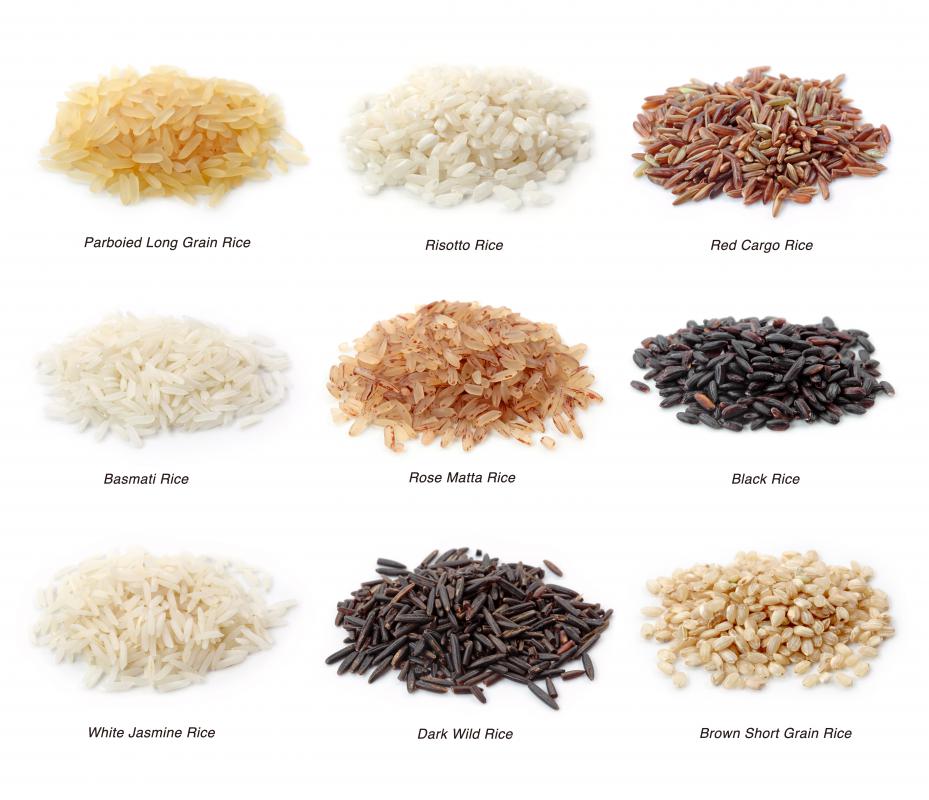At WiseGEEK, we're committed to delivering accurate, trustworthy information. Our expert-authored content is rigorously fact-checked and sourced from credible authorities. Discover how we uphold the highest standards in providing you with reliable knowledge.
What Are the Best Tips for Cooking Jasmine Rice?
The best tips for cooking jasmine rice fall into three main categories: pre-cooking preparation, water ratios, and overall cook time calculations. Jasmine rice is one of the most fragrant grains available. Cooking it properly can be frustrating at first, but with a bit of practice and experimentation, even beginner cooks can consistently get good results.
Most jasmine rice grains are sold unprocessed, which means that they have been packaged immediately after their harvest. It is usually a good idea to rinse the grains thoroughly before cooking them, both to ensure that they are free of debris and to prepare them to absorb moisture. The best way to rinse jasmine rice is to place the grains in a shallow pan, cover them completely with water, and allow them to soak for anywhere from ten minutes to an hour. Most cooks change the water periodically; the goal is end up with water that is clear, not cloudy.
Once the rinse is complete, the rice must be drained. Many cooks find draining easiest with a small sieve or a cheesecloth. This way, no grains are able to escape. Extra water can also be wrung out with relative ease.

Another tip for cooking jasmine rice concerns finding the right rice-to-water proportion. Starting with a 1:1.5 ratio of rice to water is usually a good starting place, but a lot of the calculation depends on cooking method. There are two main ways of cooking jasmine rice: in a rice cooker or on the stove. The amount of water needed varies by method, even with the same amount of rice.

A rice cooker is almost always the easiest option for cooking jasmine rice, at least from a convenience standpoint. Cooks simply add the rice, add the water, and turn the machine on: the cooker does the rest. Finding the right proportion of water to rice often requires a bit of experimentation, however. It is usually a good idea to closely monitor rice the first few times it is cooked. Rice that seems to be drying out may need more water; rice that never fully absorbs the water likely needs less.

It is often easier to get accurate results, at least the first time, over the stove, though this method is more time consuming. One of the best tips for cooking jasmine rice on the stove involves splitting the cooking into two phases: boiling and simmering. Cooks generally bring the rice and water to a rolling boil, leaving the pan uncovered, for about five minutes. This aerates the water, and allows the rice to heat up rapidly.

Cooks then cover the pot and reduce the heat. Rice left to simmer tends to absorb water better than rice that is actively boiling. A closed lid also traps steam, which helps contribute to a tender, plump finished product. Most rice packet instructions tell cooks to leave the rice undisturbed, but removing the lid and briefly stirring the cooking rice once or twice is a good way to ensure that no grains stick to the bottom of the pan, which can cause burning.

Jasmine rice is a staple in many Asian dishes, particularly those in Thai cuisine. Traditionally, Thai jasmine rice is not meant to be seasoned at all. It is usually intended to be something of a blank slate for the flavors of curries or other dishes alongside of which it is served. Just the same, many cooks choose to season their rice with butter, salt, or other seasonings. It is usually best to add such seasonings to the rice as it cooks, either by placing it in the rice cooking chamber or adding it to the pot at the simmer stage.
Sometimes it is possible to microwave jasmine rice, but this method of cooking is not generally recommended. It is usually difficult for a microwave oven to sustain the heat or steam as long as is necessary for jasmine rice to reach its peak. If a microwave is the only option, the best tips include using a shallow dish, such that moisture can be evenly distributed; using pre-boiled water to cut down on cook time; and covering the dish before cooking, so as to trap steam.
AS FEATURED ON:
AS FEATURED ON:















Discussion Comments
@fify-- The ratio I use is 2:2.5 rice to water. So that's 1:1.25. I think this ratio works best. I actually use this ratio for other types of rice too and I've never had a problem.
If you cook Jasmine rice on the stove, make sure that you put it on the lowest heat possible and the pot should get a tiny bit of air while steaming. Twenty minutes is long enough. Using a rice cooker is the easiest way to get the perfect Jasmine rice.
What is the best ratio for Jasmine rice? Does everyone use the 1:1.5 ratio?
I don't soak my Jasmine rice before I steam it, but I wash it with running cold water for a long time. Soaking the rice will make it cook faster, but I always buy fresh Jasmine rice so that's never a problem. I like to wash the rice grains for at least five minutes and I run my fingers through the grains to get all the rice dust out. When the water starts running clear, it means they are clean enough to be cooked.
I usually steam my Jasmine rice. It could be fried as well but Jasmine is so fragrant that this is not necessary. I always know when my Jasmine rice is done because the beautiful jasmine aroma from the rice cooker gives it away.
Post your comments